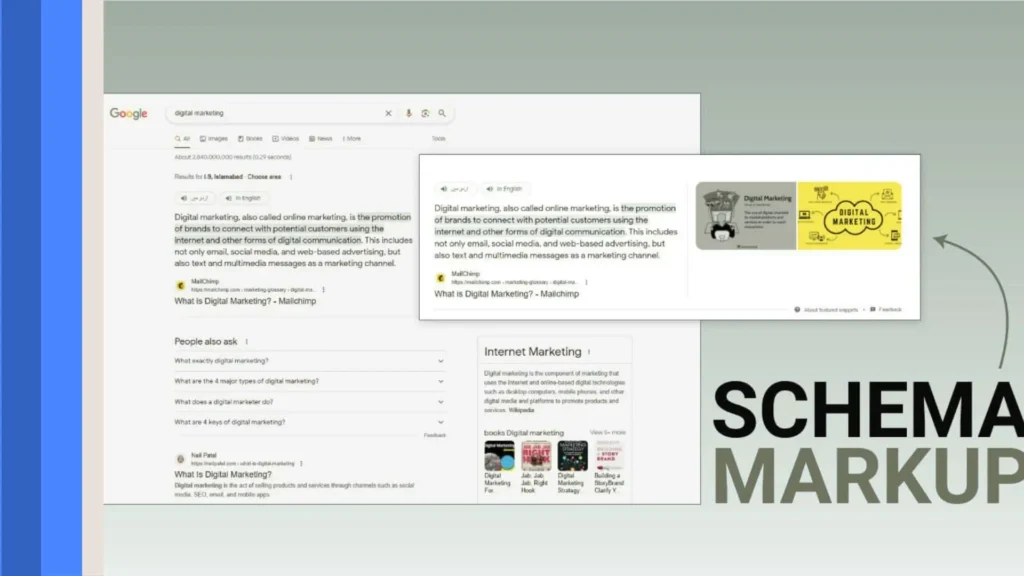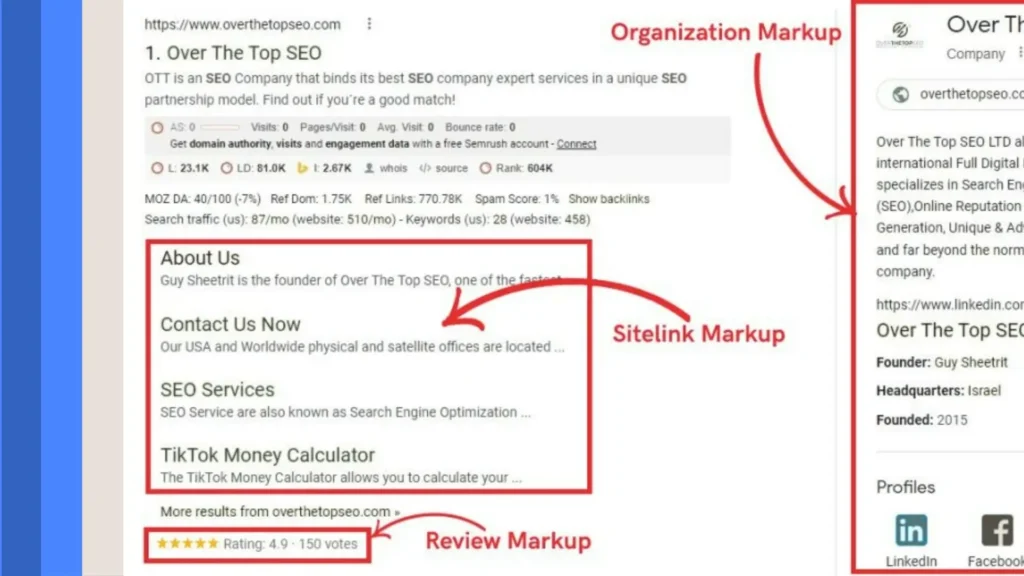The world of search engine optimisation (SEO) is a world where visibility may be all there is. Search-engine-optimised websites perform better, capture web traffic, and attract more users to the site than others ranked lower. Schema markup is one of the least-known yet very mighty tools webmasters and other digital marketers deploy in order to have a better representation on search results. However, what is schema markup, and why do you need to concern yourself with it?
Schema markup is an advanced type of code that you can find on your site that assists the search engines in understanding the meaning of your content. Search engines such as Google have the ability to use this additional information to improve your knowledge graph in the search results with pictures, star ratings, the number of reviews, and other rich snippets, which will not appear otherwise; the crawler will only read plain text. Not only are such improvements prettier to look at, but they can generate much higher click-throughs.
Knowledge of what is schema markup actually is, as well as how to utilise it, can present you with an advantage when competing with competitors within an online market as saturated as it can be. Regardless of what you want to post (a blog, an online shopping site or a business directory site), the schema markup can be used to revolutionise the appearance of your pages in search engines.
What Is Schema Markup?
So, what is schema markup in short and to the point? A structured type of data is schema markup. Structured data is a piece of code that you insert into your HTML to give search engines clear details about the contents of the pages. It employs a common vocabulary, or vocabulary, call it my Schema.org, and it defines terms also known as elements of your content.
A good example is that when there is a recipe on your site, you could consider adding schema marking such as cooking time, ingredient list, nutritional information, and other reviews carried out by users. The schema data: when Google reads a schema data, it can present the information in search results itself, making your listing followed by appearing more informative and attractive to the user.
Some of the types of content that can be marked up with schema are:
- Blog and articles
- Tickets and events
- Goods and services
- Local businesses
- Job postings
- Recipes
- Videos
- How-to manuals and FAQs
With the schema, you are making the search engines read what you have posted in a smarter manner. This may give rich output, which is listings even more enhanced in the search engine results page (SERP) with details showing, in addition, such as images, review stars, among others.
Being aware of what schema markup is will help one achieve a higher level of visibility, using more complex and data-driven techniques that have not been used in conventional SEO yet.

How Schema Markup Works
The working of schema markup begins with an understanding of how the search engines work. What search engines do is send out bots or crawlers to go through your content on your website. These bots cannot understand unless schema markup is applied to your website to detect what your page is all about through content and layout. By using a schema, you will provide those crawlers with a roadmap telling them what each of the web page elements represents.
Let’s say that your website has an event listing. Schema markup will enable you to make the name of the event, date and time, location, and even the price of admission. This specifies how search engines should understand such data and enables them to display your event in special rich results, e.g. in the event carousel displayed by Google.
When you know the right answer to the question of what schema markup is and start using it correctly, you can have the opportunity to unveil a broad array of enriched functionality, including:
- Reviewer star ratings
- Availability and Pricing of Products
- Dates and times of the event
- Breadcrumb trails
- Video previews
- FAQ sections
These additions make not only your listings prettier but also more valuable and believable to prospective visitors.
Why Schema Markup Is Important
Now that you have an idea of what is schema markup and how it works, it is time to make an exploration as to why it is important. There are several good reasons why schema markup is a significant aspect of contemporary search engine optimisation strategies.
1. Enhanced Search Visibility
Rich snippets are visually distinct in search engine results. It may be a star rating, a product price or a highlighted picture; these merchandised-buyer signs can get a user to click on your outcome.
2. Higher Click-Through Rates (CTR)
When looking at all the evidence, rich snippets can greatly improve your CTR. In that manner, when your content appears further, much more fully fleshed out and interesting in the results, the people seeking out your website are a lot a lot extra likely to click on into your website compared to the other individuals.
3. Improved Content Understanding
Schema is used for readability to search engines’ content. When Google knows more about your page, it can show it that much better in your search queries that are relevant.
4. Voice Search Optimisation
With the increasing surge of voice assistants, it is even more important to comprehend what schema markup is and put it to use. Structured information allows devices such as Google Assistant or Amazon Alexa to find more precise answers to voice search inquiries.
5. Increased Competitive Edge
Very few websites use schema markup to the best of their capability. You are ahead of your competitors, who have not yet adopted this technique of SEO by including it in your site.
Concisely, understanding what schema markup is and how to use it correctly can give your site the key to talk to search engines better, and drive user experience as well as site performance.

How to Use Schema Markup
The procedure of introducing schema markup may sound complicated, but it is less so than you may think. Individuals who are developers and non-tech people who own a site can employ several techniques to add schema to their sites.
1. With the help of a Schema Markup Generator
One of the simplest options is to go with a schema generator when you have no idea what schema markup is and you want to get some practice. These tools will help you through the passage of the necessary data and will show you the piece of code to paste onto your web page.
You simply:
- Select your content type (e.g., product, article, event)
- Fill in the necessary details
- Copy the generated code and paste it into your HTML
2. Using WordPress Plugins
In the case of WordPress users, it is easier to carry out schema implementation. With the assistance of such plugins as Schema Pro, Yoast SEO, and Rank Math, you can add schema markup to pages and posts even without having to know how to code.
Such plugins provide options which automatically apply the schema according to your content. It is particularly useful when you have a blog or online store, or are making a local business website, and need to add structured data, but you have no desire to get technical about it.
3. Manually Adding Schema Markup
Manual entry of schema markup into the HTML can be done as per experience in coding, which may be in JSON-LD or Microdata formats. The reason why Google recommends JSON-LD is that it is clean and will not interfere with your content, as the structured data remains separate.
Once you know what schema markup is and how to implement it in a manual way, you will have a greater ability to customise your use of structured data to fit your unique content components.
4. Selecting the Right Schema Type
At schema.org, there are hundreds of schema type definitions. The common ones are as follows:
- Article – Blogs and news stories
- Product- E-commerce products
- LocalBusiness- To be used by local shops and service providers
- Event – in case of concerts, webinars, and so on.
- FAQ Page-Frequently Asked Questions
The more applicable your schema type is to your content, your data is the more likely you are to achieve rich results in the search engines.
How to Test Your Schema Markup
It is of no use knowing what schema markup to use when your application of the same fails. This is why it is important that after creating the schema, testing is the final step.
It is possible to assist with two main tools:
- Rich Results Test Search Engine Results with special features. The Rich Results Test displays whether your schema is eligible to be enriched with special search results
- Schema Markup Validator-Checks to see whether your markup is valid and that it is of the desired format
They study your web page and inform you as to whether there exist any mistakes, warnings, or errors that may impact your structured data. Once you have tested, you will be able to make any adjustments necessary to mark up properly so that any search engine may clearly understand your markup content.

Conclusion
So, what is schema markup? It is providing the search machines with a better comprehension of your site, which will ensure making your material comes across more enticingly and factually in search engines. Markup Scheme doesn’t just make your listings more beautiful, but it also gives your listings a better and more effective appearance.
Schema markup is one way of making your site more noticeable and searchable in an organised and responsive form, whether you are looking to increase the volume of people clicking on your site or to have your site optimised for voice search or simply better indexing in general.
By understanding what schema markup is and mastering its techniques to implement it, you can have your site stand out among the rest of the competition and have your content seen by the people who should see it.
Frequently Asked Questions
In SEO, schema markup is the type of structured data used in webpage HTML code in an attempt to enable search engines to grasp its content better. It allows richer listings known as rich snippets, such as star rating, event times, and product information, which can enhance visibility, click-through rates.
The significance of schema markup is that it increases the search performance of a webpage by improving the level of listing in the search results. It makes it easier to understand content on the web, facilitates search using voice, and marketing power by providing rich snippet information that is easily linked.
Adding schema markup to your site can be done by either editing your site via JSON-LD code, a schema generator tool or with the help of SEO plugins such as Yoast, Schema Pro or Rank Math (all of this especially in WordPress). These techniques do not demand much or any coding.
Even though schema markup is not a strict ranking factor, it still has a chance to boost your rankings by enhancing click-through rates. Improved search listings generate higher attention, indicating the relevance, which may also improve the performance of the site in the long run, concerning its search engine optimisation.






